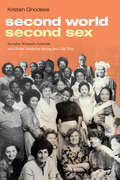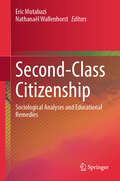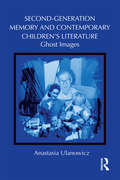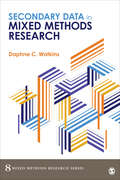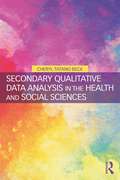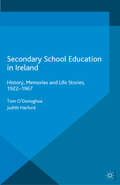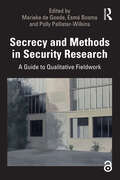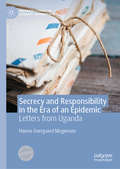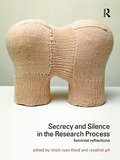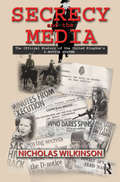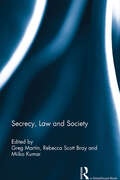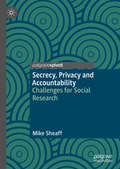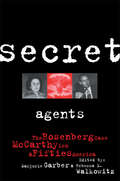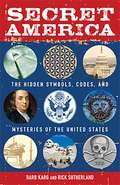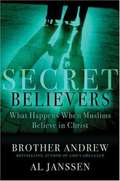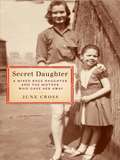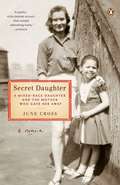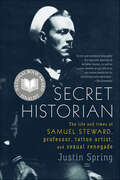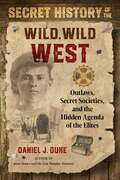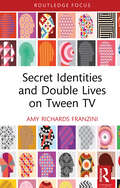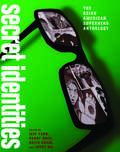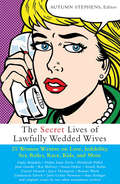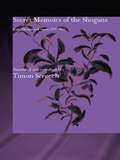- Table View
- List View
Second World, Second Sex: Socialist Women's Activism and Global Solidarity during the Cold War
by Kristen GhodseeWomen from the state socialist countries in Eastern Europe—what used to be called the Second World—once dominated women’s activism at the United Nations, but their contributions have been largely forgotten or deemed insignificant in comparison with those of Western feminists. <P><P> In Second World, Second Sex Kristen Ghodsee rescues some of this lost history by tracing the activism of Eastern European and African women during the 1975 United Nations International Year of Women and the subsequent Decade for Women (1976-1985). <P><P>Focusing on case studies of state socialist Bulgaria and nonaligned but socialist-leaning Zambia, Ghodsee examines the feminist networks that developed between the Second and Third Worlds and shows how alliances between socialist women challenged American women’s leadership of the global women’s movement. <P><P>Drawing on interviews and archival research across three continents, Ghodsee argues that international ideological competition between capitalism and socialism profoundly shaped the world women inhabit today.
Second-Class Citizenship: Sociological Analyses and Educational Remedies
by Nathanaël Wallenhorst Eric MutabaziA number of features of the contemporary period are preventing people from exercising their citizenship: the acceleration and permanent change in the conditions shaping habitability of planet Earth, the digital and techno-scientific revolution, the rise of religious and political radicalisation, the explosion of social inequalities, the hegemony of the economic drive to maximise individual interests, etc. For many individuals, citizenship appears to be prevented at the first hurdle. What is more, though officially or legally, it is not possible to speak of second-class citizenship-- so what can be done when the actors themselves use such terminology? There is something essential here which must be taken into account as a basis for thinking about the social, its inequalities and its injustices. The authors of this book propose the notion of 'second-class citizenship' as a way of thinking about the scale of contemporary social and political inequalities. In view of this observation, the contributors outline a movement based on the conviction that education is the repository of the power to prepare for the future. How can we learn to build a shared world together and overcome the obstacles that prevent us from doing so? How can we learn new habits of relationships marked by responsibility and hospitality? The collective reflection in this book lends credence to the way in which players talk about their experience, even experiencing differences in their ability to participate in the mechanisms of power. This book presents empirical studies and conceptual tools for thinking about the impact of economic factors on the ways in which citizens participate in the decisions of power. This book is particularly suited for educators as well as policy-makers and researchers.
Second-Generation Memory and Contemporary Children's Literature: Ghost Images (Children's Literature and Culture)
by Anastasia UlanowiczWinner of the Children’s Literature Association Book Award This book visits a range of textual forms including diary, novel, and picturebook to explore the relationship between second-generation memory and contemporary children’s literature. Ulanowicz argues that second-generation memory — informed by intimate family relationships, textual mediation, and technology — is characterized by vicarious, rather than direct, experience of the past. As such, children’s literature is particularly well-suited to the representation of second-generation memory, insofar as children’s fiction is particularly invested in the transmission and reproduction of cultural memory, and its form promotes the formation of various complex intergenerational relationships. Further, children’s books that depict second-generation memory have the potential to challenge conventional Western notions of selfhood and ethics. This study shows how novels such as Lois Lowry’s The Giver (1993) and Judy Blume’s Starring Sally J Freedman as Herself (1977) — both of which feature protagonists who adapt their elders’ memories into their own mnemonic repertoires — implicitly reject Cartesian notions of the unified subject in favor of a view of identity as always-already social, relational, and dynamic in character. This book not only questions how and why second-generation memory is represented in books for young people, but whether such representations of memory might be considered 'radical' or 'conservative'. Together, these analyses address a topic that has not been explored fully within the fields of children’s literature, trauma and memory studies, and Holocaust studies.
Secondary Data in Mixed Methods Research (Mixed Methods Research Series)
by Daphne C. WatkinsSecondary Data in Mixed Methods Research by Daphne C. Watkins, the latest contribution to the Mixed Methods Research Series, offers unique and necessary instruction in this growing topic. With the increasing amount of secondary data available through journals and repositories, researchers have a trove of sources for new investigations at their fingertips, but few books to guide them. This brief text provides readers with a step-by-step procedure for incorporating secondary data into various mixed methods research designs, as well as identifying key characteristics of existing datasets that make them good candidates for mixed methods projects and giving ideas for new uses of secondary data. Introductory chapters help the reader understand the “what” and “why” of secondary data. Subsequent chapters address the use of secondary data in convergent, exploratory sequential, explanatory sequential, and other complex research designs. The final chapters delve into writing and reporting on projects before, during, and after the project. Quotes throughout the chapter help readers remember key bits of knowledge, while learning objectives and summaries in each chapter structure the reading experience. Application questions at the end of each chapter help readers recall information and apply it to their own research projects. By emphasizing how to use existing qualitative and quantitative datasets in mixed methods research, Secondary Data in Mixed Methods Research will help readers answer new and ongoing questions in social science research.
Secondary Data in Mixed Methods Research (Mixed Methods Research Series)
by Daphne C. WatkinsSecondary Data in Mixed Methods Research by Daphne C. Watkins, the latest contribution to the Mixed Methods Research Series, offers unique and necessary instruction in this growing topic. With the increasing amount of secondary data available through journals and repositories, researchers have a trove of sources for new investigations at their fingertips, but few books to guide them. This brief text provides readers with a step-by-step procedure for incorporating secondary data into various mixed methods research designs, as well as identifying key characteristics of existing datasets that make them good candidates for mixed methods projects and giving ideas for new uses of secondary data. Introductory chapters help the reader understand the “what” and “why” of secondary data. Subsequent chapters address the use of secondary data in convergent, exploratory sequential, explanatory sequential, and other complex research designs. The final chapters delve into writing and reporting on projects before, during, and after the project. Quotes throughout the chapter help readers remember key bits of knowledge, while learning objectives and summaries in each chapter structure the reading experience. Application questions at the end of each chapter help readers recall information and apply it to their own research projects. By emphasizing how to use existing qualitative and quantitative datasets in mixed methods research, Secondary Data in Mixed Methods Research will help readers answer new and ongoing questions in social science research.
Secondary Qualitative Data Analysis in the Health and Social Sciences
by Cheryl Tatano BeckDespite a long history in quantitative research, it is only recently that enthusiasm for secondary analysis of qualitative data has gained momentum across health and social science disciplines. Given that researchers have long known the inordinate amount of time and energy invested in conducting qualitative research, the appeal of secondary analysis of qualitative data is clear. Involving the use of an existing dataset to answer research questions that are different from those asked in the original study, this method allows researchers to once again make use of their hard-earned qualitative dataset and to listen to their participants’ voices to the best of their ability in order to improve care and promote understanding. As secondary qualitative data analysis continues to evolve, more methodological guidance is needed. This book outlines three approaches to secondary data analysis and addresses the key issues that researchers need to wrestle with, such as ethical considerations, voice, and representation. Intellectual and interpretive hazards that can jeopardize the outcome of these analyses are highlighted and discussed, as are the criteria for assessing their quality and trustworthiness. Written as a thought-provoking guide for qualitative researchers from across the health and social sciences, this text includes a review of the state of the science in nursing and a number of in-depth illustrative case studies.
Secondary School Education in Ireland: History, Memories and Life Stories, 1922 - 1967 (Historical Studies in Education)
by Tom O'Donoghue Judith HarfordAdopting a life story approach, this book explores the memories of those who attended Irish secondary schools prior to 1967. It serves to initiate and enhance the practice of remembering secondary school education amongst those who attended secondary schools not just in Ireland, but around the world.
Secrecy and Methods in Security Research: A Guide to Qualitative Fieldwork
by Marieke De Goede Esmé Bosma Polly Pallister-WilkinsThis book analyses the challenges of secrecy in security research, and develops a set of methods to navigate, encircle and work with secrecy. How can researchers navigate secrecy in their fieldwork, when they encounter confidential material, closed-off quarters or bureaucratic rebuffs? This is a particular challenge for researchers in the security field, which is by nature secretive and difficult to access. This book creatively assesses and analyses the ways in which secrecies operate in security research. The collection sets out new understandings of secrecy, and shows how secrecy itself can be made productive to research analysis. It offers students, PhD researchers and senior scholars a rich toolkit of methods and best-practice examples for ethically appropriate ways of navigating secrecy. It pays attention to the balance between confidentiality, and academic freedom and integrity. The chapters draw on the rich qualitative fieldwork experiences of the contributors, who did research at a diversity of sites, for example at a former atomic weapons research facility, inside deportation units, in conflict zones, in everyday security landscapes, in virtual spaces and at borders, bureaucracies and banks. The book will be of interest to students of research methods, critical security studies and International Relations in general.
Secrecy and Responsibility in the Era of an Epidemic: Letters from Uganda (Palgrave Studies in Literary Anthropology)
by Hanne Overgaard MogensenA narrative ethnography about a Ugandan woman and her relatives, this novelistic, fine-grained volume shows how global questions of responsibility and inequity travel in family networks and confront people with decisions about life and death. It is a story of existence under extremely challenging conditions, about belonging and marginalization, about the opacity and ambiguity of social relations, and about growing up in a country haunted by violence and civil war only to be later lifted by optimism and devastated anew by the AIDS epidemic. The story draws on long-term fieldwork and letters from the woman who takes centre stage in the story, while at once providing unique and privileged insight into the ethical challenges of a research method that demands personal involvement that is ultimately withdrawn for scholarly analysis.
Secrecy and Silence in the Research Process: Feminist Reflections (Transformations)
by Rosalind Gill Róisín Ryan-FloodFeminist research is informed by a history of breaking silences, of demanding that women’s voices be heard, recorded and included in wider intellectual genealogies and histories. This has led to an emphasis on voice and speaking out in the research endeavour. Moments of secrecy and silence are less often addressed. This gives rise to a number of questions. What are the silences, secrets, omissions and and political consequences of such moments? What particular dilemmas and constraints do they represent or entail? What are their implications for research praxis? Are such moments always indicative of voicelessness or powerlessness? Or may they also constitute a productive moment in the research encounter? Contributors to this volume were invited to reflect on these questions. The resulting chapters are a fascinating collection of insights into the research process, making an important contribution to theoretical and empirical debates about epistemology, subjectivity and identity in research. Researchers often face difficult dilemmas about who to represent and how, what to omit and what to include. This book explores such questions in an important and timely collection of essays from international scholars.
Secrecy and the Media: The Official History of the United Kingdom's D-Notice System (Government Official History Series)
by Nicholas John WilkinsonSecrecy and the Media is the first book to examine the development of the D-Notice system, which regulates the UK media's publication of British national security secrets. It is based on official documents, many of which have not previously been available to a general audience, as well as on media sources. From Victorian times, British governments have consistently seen the need, in the public interest, to prevent the media publishing secret information which would endanger national security. The UK media have meanwhile continuously resisted official attempts to impose any form of censorship, arguing that a free press is in the public interest. Both sides have normally seen the pitfalls of attempting to resolve this sometimes acrimonious conflict of interests by litigation, and have together evolved a system of editorial self-regulation, assisted by day-to-day independent expert advice, known colloquially as the D-Notice System. The book traces the development of this system from nineteenth-century colonial campaigns, through two world wars, to modern operations and counter-terrorism in the post-Cold War era, up to the beginning of the Labour government in 1997. Examples are drawn from media, political and official sources (some not yet open), and cover not only defence issues (including Special Forces), but also the activities of the secret intelligence services MI5, MI6 and GCHQ. These cases relate principally to the UK, but also to American and other allies' interests. The story of how this sometimes controversial institution now operates in the modern world will be essential reading for those in the media and government departments, and for academics and students in the fields of security, defence and intelligence, as well as being an accessible exposé for the general reader. Nicholas Wilkinson served in the Royal Navy 1959-98, and from 1999 to 2004 he ran the independent Defence, Press and Broadcasting Advisory Committee. He was a Press Complaints Commissioner from 2005 to 2008, and is a Cabinet Office Historian.
Secrecy, Law and Society
by Greg Martin Rebecca Scott Bray Miiko KumarCommentators have shown how a ‘culture of security’ ushered in after the terrorist attacks of 11 September 2001 has involved exceptional legal measures and increased recourse to secrecy on the basis of protecting public safety and safeguarding national security. In this context, scholars have largely been preoccupied with the ways that increased security impinges upon civil liberties. While secrecy is justified on public interest grounds, there remains a tension between the need for secrecy and calls for openness, transparency and disclosure. In law, secrecy has implications for the separation of powers, due process, and the rule of law, raising fundamental concerns about open justice, procedural fairness and human rights. Beyond the counterterrorism and legal context, scholarly interest in secrecy has been concerned with the credibility of public and private institutions, as well as the legacies of secrecy across a range of institutional and cultural settings. By exploring the intersections between secrecy, law and society, this volume is a timely and critical intervention in secrecy debates traversing various fields of legal and social inquiry. It will be a useful resource for academic researchers, university teachers and students, as well as law practitioners and policymakers interested in the legal and socio-legal dimensions of secrecy.
Secrecy, Privacy and Accountability: Challenges for Social Research
by Mike SheaffPublic mistrust of those in authority and failings of public organisations frame disputes over attribution of responsibility between individuals and systems. Exemplified with examples, including the Aberfan disaster, the death of Baby P, and Mid Staffs Hospital, this book explores parallel conflicts over access to information and privacy.The Freedom of Information Act (FOIA) allows access to information about public organisations but can be in conflict with the Data Protection Act, protecting personal information. Exploring the use of the FOIA as a research tool, Sheaff offers a unique contribution to the development of sociological research methods, and debates connected to privacy and secrecy in the information age. This book will provide sociologists and social scientists with a fresh perspective on contemporary issues of power and control.
Secret Agents: The Rosenberg Case, McCarthyism and Fifties America (CultureWork: A Book Series from the Center for Literacy and Cultural Studies at Harvard)
by Marjorie Garber Rebecca L. WalkowitzWhen the American Bar Association recreated the trial of Ethel and Julius Rosenberg on the fortieth anniversary of their execution, the jury acquitted the "mock Rosenbergs," finding that in today's courts they would not have been convicted of espionage. The 1950s trial of the Rosenbergs on charges of "Atomic Spying" and "stealing the secrets of the Atomic bomb" was a major event of Cold War America, galvanizing public opinion on all sides of the question. Secret Agents presents essays by lawyers, cultural critics, social historians and historians of science, as well as a reconsideration of the Rosenbergs by their younger son, Robert Meeropol. Secret Agents gives new resonance to a history we have for too long been willing to forget.
Secret America: The Hidden Symbols, Codes and Mysteries of the United States
by Barb Karg Rick SutherlandThe Washington Monument.The pyramid on the $1 bill.The Skull and Bones Society at Yale University.Common American icons-or secret symbols? From our founding fathers to our most prestigious institutions, this is a nation built on such secret symbols, rites, and rituals. So forget the textbook version of history-and embark on a fascinating and fantastic journey of America's hidden past.This tell-all handbook is your personal guide to the secret-laden people, places, and things of our great nation, including:Sign-filled national treasures in museums from coast to coastAncient mysteries of our most familiar cities, landmarks, and parksHotbeds of current Masonic, Kabbalistic, and Rosicrucian activityFreemason-planned architecture of Boston, New York, Philadelphia, and Washington, D.C.Covert clubs, societies, and associations of the ultra-rich and powerful From the U.S. Capitol in Washington, D.C., to the Institute of Noetic Sciences in Petaluma, California, this book is all you need to discover the true nature of the oldest republic on Earth-past, present, and future!
Secret Believers: What Happens When Muslims Believe in Christ
by Brother Andrew Al JanssenFrom the bestselling author of "Gods Smuggler" comes this riveting true story of the Middle Eastern Church struggling to come to grips with hostile governments, terrorist acts, and an influx of Muslims coming to Christ.
Secret Daughter
by June CrossA powerful memoir about the complicated but ultimately loving relationship between a black daughter and her white mother Secret Daughter is a deftly drawn and moving portrait of a childhood spent in two very different worlds: one white, one black. In 1957, when June Cross was four years old, she was sent by her white mother to live with a black family in Atlantic City. Her mother, Norma, had left June's abusive father, a comic in the well-known black vaudeville duo Stump and Stumpy, and gave June up when it became clear that her dark-skinned, kinky-haired child could no longer "pass. " Within her adopted family, June struggled with her identity as the black radicalism of the times collided head on with her family's more traditional ideals. Summer vacations were spent with her mother, now in Hollywood and married to F Troop TV actor Larry Storch. For many years, Norma, afraid that Larry's career would suffer if anyone discovered the truth about her illegitimate daughter, told friends and reporters that June was adopted. Secret Daughter, which grew out of Cross's Emmy Award-winning documentary, traces this thorny story with poignancy and skill. It is both a vivid snapshot of race relations in America and an inspiring journey of understanding between a mother and daughter.
Secret Daughter: A Mixed-Race Daughter and the Mother Who Gave Her Away
by June CrossJune Cross was born in 1954 to Norma Booth, a glamorous, aspiring white actress, and James "Stump" Cross, a well-known black comedian. Sent by her mother to be raised by black friends when she was four years old and could no longer pass as white, June was plunged into the pain and confusion of a family divided by race. Secret Daughter tells her story of survival. It traces June's astonishing discoveries about her mother and about her own fierce determination to thrive. This is an inspiring testimony to the endurance of love between mother and daughter, a child and her adoptive parents, and the power of community.
Secret Historian: The Life and Times of Samuel Steward, Professor, Tattoo Artist, and Sexual Renegade
by Justin Spring2010 National Book Award Finalist for NonfictionDrawn from the secret, never-before-seen diaries, journals, and sexual records of the novelist, poet, and university professor Samuel M. Steward, Secret Historian is a sensational reconstruction of one of the more extraordinary hidden lives of the twentieth century. An intimate friend of Gertrude Stein, Alice B. Toklas, and Thornton Wilder, Steward maintained a secret sex life from childhood on, and documented these experiences in brilliantly vivid (and often very funny) detail.After leaving the world of academe to become Phil Sparrow, a tattoo artist on Chicago's notorious South State Street, Steward worked closely with Alfred Kinsey on his landmark sex research. During the early 1960s, Steward changed his name and identity once again, this time to write exceptionally literate, upbeat pro-homosexual pornography under the name of Phil Andros.Until today he has been known only as Phil Sparrow—but an extraordinary archive of his papers, lost since his death in 1993, has provided Justin Spring with the material for an exceptionally compassionate and brilliantly illuminating life-and-times biography. More than merely the story of one remarkable man, Justin Spring's Secret Historian is a moving portrait of homosexual life long before Stonewall and gay liberation.
Secret History of the Wild, Wild West: Outlaws, Secret Societies, and the Hidden Agenda of the Elites
by Daniel J. Duke• Offers evidence from Jesse James&’s secret encoded diaries • Examines Jesse James&’s close ties with other notorious outlaws, such as Johnny Ringo, Jesse Evans, and Billy the Kid • Shows how Jesse James was related, by blood or marriage, to powerful people in law enforcement and politics, including the elite families behind the Copperheads and the Knights of the Golden Circle organizations Jesse James and many other Old West outlaws were much more than just wild cowboys. As author Daniel Duke--the great-great-grandson of Jesse James--reveals, James and other infamous outlaws were part of a larger organization, centuries old, that has affected U.S. history from the small, rural streets of early America to the highest levels of the nation&’s government, with continuing influence to this day. Drawing on his great-great-grandfather&’s secret diaries, Duke unravels the hidden history of the Wild West to expose the outlaws, politicians, and secret societies who were pulling strings behind the scenes. He examines Jesse James&’s close ties with other notorious outlaws, such as Johnny Ringo, Jesse Evans, and Billy the Kid, and demonstrates not only how James faked his death and lived out his life under an alias, but how Billy the Kid did the same. He also details how both Jesse James and Billy the Kid continued their work for the nameless organization after their faked deaths. Exploring how Jesse James was related, by blood or marriage, to powerful people in law enforcement and politics, Duke details James&’s connections to the Baylor family, who founded Baylor University in Waco, Texas, and other elite families who were instrumental in founding and leading the Copperheads and the Knights of the Golden Circle organizations before, during, and after the Civil War. The author shows how Jesse James was connected to former U.S. presidents Lyndon Baines Johnson and Harry S. Truman as well as LBJ&’s man in the shadows, Texas mob figure Billie Sol Estes. Exposing the secret agenda behind the outlaw gangs of the Wild West, Duke also reveals the stealthy war between the secret organization and its opposition that has been waged in the shadows for centuries.
Secret Identities and Double Lives on Tween TV (Routledge Focus on Television Studies)
by Amy Richards FranziniSecret Identities and Double Lives on Tween TV in introduces readers to the concepts of tweenhood and television (TV) tropes by providing historical and theoretical contexts and reviewing the history of TV targeted to tweens.Through a qualitative analysis of various live-action sitcoms, this book explores the popularity of programming featuring characters leading secret lives and targeted to tweens. By unpacking various theoretical explanations of this distinct period of life and examining them through the critical lens of the content of these tween TV shows that feature secret identities, the book offers a unique understanding of the tween experience woven in the nexus of power, morality, friendship, romance, family life and self-identity.This book’s analysis and understanding would benefit children’s media scholars and researchers, students of media studies, communication studies, cultural studies, adolescent studies, and child development.
Secret Identities: The Asian American Superhero Anthology
by Jerry Ma Parry Shen Jeff Yang Keith ChowAppealing to both comics fans and Asian Americans seeking to claim their place in American culture, Secret Identities makes brilliant use of the conventions of the superhero comic book to expose the real face of the Asian American experience.<P><P>This groundbreaking graphic anthology brings together leading Asian American creators in the comics industry-including Gene Yang (National Book Award finalist for American Born Chinese), Bernard Chang (Wonder Woman), Greg Pak (The Hulk), and Christine Norrie (Black Canary Wedding Special )-to craft original graphical short stories set in a compelling "shadow history" of our country: from the building of the railroads to the Japanese American internment, the Vietnam airlift, the murder of Vincent Chin, and the incarceration of Dr. Wen Ho Lee.Entertaining and enlightening, Secret Identities offers whiz-bang action, searing satire, and thoughtful commentary from a community too often overlooked by the cultural mainstream, while showcasing a vivid cross-section of the talents whose imagination and creativity is driving the contemporary comics renaissance.
Secret Lives of Lawfully Wedded Wives
by Autumn StephensSome marriages are made in heaven, and others, quite frankly, are not. This anthology collects the private reflections of 25 well-known women writers, some of whom speak under the liberating cloak of anonymity. They reveal the truth about their marriages, their divorces, and sometimes, their decisions to remain single. The essays here chronicle the highs and lows of romantic relationships, the ebb and flow of love and desire, and the many alternatives to traditional matrimony. With topics ranging from infidelity and true love to orgasms, children, career power struggles, race issues, and aging, these are stories that empower women to make sense of their own lives.
Secret Memoirs of the Shoguns: Isaac Titsingh and Japan, 1779-1822
by Isaac TitsinghIsaac Titsingh was intermittently head of the Japan factory (trading station) of the Dutch East India Company 1780-94. He was a career merchant, but unusual in having a classical education and training as a physician. His impact in Japan was enormous, but he left disappointed in the ability of the country to embrace change. After many years in Java, India and China, he came to London, and then settled in Paris where he devoted himself to compiling translations of prime Japanese texts. It is one of the most exciting anthologies of the period and reveals the almost unknown world of eighteenth-century Japan, discussing politics, history, poetry and rituals. The Illustrations of Japan appeared posthumously in 1821-1822 in English, French and Dutch. This fully annotated edition makes the original English version available for the first time in nearly two centuries
